Research on a New Type of Rigid-Flexible Coupling 3-DOF Micro-Positioning Platform
Abstract
:1. Introduction
2. Mechanism Design and Analysis
2.1. Mechanism Design
2.2. Flexibility Matrix Method Modeling
2.3. Simulation Analysis
2.3.1. Static Analysis
2.3.2. Modal Analysis
3. Experiment
3.1. Experimental Method
3.2. Results and Analysis
3.2.1. Output Characteristic
3.2.2. Positioning Accuracy
3.2.3. Frequency and Amplitude
3.2.4. Bearing Performance
4. Conclusions
- (1)
- A symmetrical rigid-flexible coupling micro-positioning platform is designed, which is composed of three groups of parallel and symmetrical flexible drive mechanisms and rigid platforms. Each group of symmetrical parallel flexible hinges is provided with a wedge structure in the middle.
- (2)
- The flexibility matrix method is used to model the flexible driving structure of micro-positioning platform. When equivalent load (100 N) is applied to the output end of a group of piezoelectric ceramic actuators, the deformation of flexure hinge mechanism is 47.8 μm. the static simulation analysis with ANSYS shows that the deformation is 52.4 μm, and the error is 7.08%. The first-order natural frequency of the flexible driving mechanism is 1797.03 Hz, which shows that the micro-positioning platform has a high natural frequency.
- (3)
- A symmetrical rigid flexible coupling micro-positioning platform was developed. The output characteristics, positioning accuracy, the relationship between frequency and displacement amplitude and the bearing capacity of the micro-positioning platform were tested. The positioning accuracy and output displacement response have good tracking performance to the given initial voltage, which shows that the platform has high positioning accuracy and good motion characteristics. The micro-positioning platform has a large stroke and can work in a low frequency state. When the frequency increases from 5 Hz to 50 Hz, the amplitude of the output trajectory of the micro-positioning platform decreases with the increase of the frequency, and the travel in the Z-direction is greater than that in the X-direction and Y-direction. Through the bearing performance test of the micro-positioning platform, the output stiffness of the flexure hinge driving mechanism is 12.304 N/μm, and the force on the piezoelectric ceramic actuator is small when the micro-positioning platform is under load, which indicates that the micro-positioning platform has good load-bearing performance.
Author Contributions
Funding
Conflicts of Interest
References
- Gozen, B.A.; Ozdoganlar, O.B. Design and evaluation of a mechanical nanomanufacturing system for nanomilling. Precis. Eng. 2012, 36, 19–30. [Google Scholar] [CrossRef]
- Zhang, X.; Zhang, X.; Wu, H.; Gan, J.; Li, H. A high accuracy algorithm of displacement measurement for a micro-positioning stage. AIP Adv. 2017, 7, 055301. [Google Scholar] [CrossRef] [Green Version]
- Huang, H.; Zhao, W.; Mi, J.; Yang, J.; Wan, S.; Xu, L.; Ma, Z. A novel and compact nanoindentation device for in situ nanoindentation tests inside the scanning electron microscope. AIP Adv. 2012, 2, 012104. [Google Scholar] [CrossRef] [Green Version]
- Lin, J.; Han, J.; Lu, M.; Gu, Y.; Zhu, W. Development of nonresonant elliptical vibration cutting device based on parallel piezoelectric actuator. AIP Adv. 2017, 7, 035304. [Google Scholar]
- Kenton, B.J.; Leang, K.K. Design and control of a three-axis serial-kinematic high-bandwidth nanopositioner. IEEE/ASME Trans. Mechatron. 2012, 17, 356–369. [Google Scholar] [CrossRef]
- Li, Y.; Xu, Q. Modeling and performance evaluation of a flexure-based XY parallel micromanipulator. Mech. Mach. Theory 2009, 44, 2127–2152. [Google Scholar] [CrossRef]
- Bhagat, U.; Shirinzadeh, B.; Clark, L.; Chea, P.; Qin, Y.; Tian, Y.; Zhang, D. Design and analysis of a novel flexure-based 3-DOF mechanism. Mech. Mach. Theory 2014, 74, 173–187. [Google Scholar] [CrossRef]
- Meng, Q.; Li, Y.; Xu, J. A novel analytical model for flexure-based proportion compliant mechanisms. Precis. Eng. 2014, 38, 449–457. [Google Scholar] [CrossRef]
- Wang, P.; Xu, Q. Design of a flexure-based constant-force XY precision positioning stage. Mech. Mach. Theory 2017, 108, 1–13. [Google Scholar] [CrossRef]
- Arata, J.; Kogiso, S.; Sakaguchi, M.; Nakadate, R.; Oguri, S.; Uemura, M.; Byunghyun, C.; Akahoshi, T.; Ikeda, T.; Hashizume, M. Articulated minimally invasive surgical instrument based on compliant mechanism. Int. J. Comput. Assist. Radiol. Surg. 2015, 10, 1837–1843. [Google Scholar] [CrossRef]
- Li, H.; Hao, G. Position-Space-Based Design of a Symmetric Spatial Translational Compliant Mechanism for Micro-/Nano-Manipulation. Micromachines 2018, 9, 189. [Google Scholar] [CrossRef] [PubMed] [Green Version]
- Polit, S.; Dong, J. Design of high-bandwidth high-precision flexure-based nanopositioning modules. J. Manuf. Syst. 2009, 28, 71–77. [Google Scholar] [CrossRef]
- Li, Y.; Xu, Q. A Novel Piezoactuated XY Stage with Parallel, Decoupled, and Stacked Flexure Structure for Micro-/Nanopositioning. IEEE Trans. Ind. Electron. 2011, 58, 3601–3615. [Google Scholar] [CrossRef]
- Lv, B.; Wang, G.; Li, B.; Zhou, H.; Hu, Y. Research on a 3-DOF motion device based on the flexible mechanism driven by the piezoelectric actuators. Micromachines 2018, 9, 578. [Google Scholar] [CrossRef] [Green Version]
- Kim, M.; Lee, D.W.; Lee, S.; Kim, Y.; Jung, Y. Effects of hinge design of horizontal-swing fast tool servo (HFTS) for micro-patterning on a roll. Int. J. Adv. Manuf. Technol. 2018, 95, 233–241. [Google Scholar] [CrossRef]
- Xu, Q.; Li, Y. Analytical modeling, optimization and testing of a compound bridge-type compliant displacement amplifier. Mech. Mach. Theory 2011, 46, 183–200. [Google Scholar] [CrossRef]
- Wang, R.; Zhang, X. A planar 3-DOF nanopositioning platform with large magnification. Precis. Eng. 2016, 46, 221–231. [Google Scholar] [CrossRef] [Green Version]
- Xu, Q. A novel compliant micropositioning stage with dual ranges and resolutions. Sens. Actuators A Phys. 2014, 205, 6–14. [Google Scholar] [CrossRef]
- Sun, X.; Yang, B. A new methodology for developing flexure-hinged displacement amplifiers with micro-vibration suppression for a giant magnetostrictive micro drive system. Sens. Actuators A Phys. 2017, 263, 30–43. [Google Scholar] [CrossRef]
- Kim, J.J.; Choi, Y.M.; Ahn, D.; Hwang, B.; Gweon, D.G.; Jeong, J. A millimeter-range flexure-based nano-positioning stage using a self-guided displacement amplification mechanism. Mech. Mach. Theory 2012, 50, 109–120. [Google Scholar] [CrossRef]
- Wang, R.; Zhang, X. Optimal design of a planar parallel 3-DOF nanopositioner with multi-objective. Mech. Mach. Theory 2017, 112, 61–83. [Google Scholar] [CrossRef]
- Zhang, X.; Xu, Q. Design and testing of a new 3-DOF spatial flexure parallel micropositioning stage. Int. J. Precis. Eng. Manuf. 2018, 19, 109–118. [Google Scholar] [CrossRef]
- Zhu, W.L.; Zhu, Z.; Guo, P.; Ju, B.F. A novel hybrid actuation mechanism based XY nanopositioning stage with totally decoupled kinematics. Mech. Syst. Signal Process. 2018, 99, 747–759. [Google Scholar] [CrossRef]
- Tian, Y.; Ma, Y.; Wang, F.; Lu, K.; Zhang, D. A novel XYZ micro/nano positioner with an amplifier based on L-shape levers and half-bridge structure. Sens. Actuators A Phys. 2020, 302, 111777. [Google Scholar] [CrossRef]
- Lee, J.W.; Li, Y.C.; Chen, K.S.; Liu, Y.H. Design and control of a cascaded piezoelectric actuated two-degrees-of-freedom positioning compliant stage. Precis. Eng. 2016, 45, 374–386. [Google Scholar] [CrossRef]
- Guo, Z.; Tian, Y.; Liu, C.; Wang, F.; Liu, X.; Shirinzadeh, B.; Zhang, D. Design and control methodology of a 3-DOF flexure-based mechanism for micro/nano-positioning. Robot. Comput. Integr. Manuf. 2015, 32, 93–10594. [Google Scholar] [CrossRef] [Green Version]
- Li, J.; Liu, H.; Zhao, H. A Compact 2-DOF Piezoelectric-Driven Platform Based on “Z-Shaped” Flexure Hinges. Micromachines 2017, 8, 245. [Google Scholar] [CrossRef] [Green Version]
- Cai, K.; Tian, Y.; Wang, F.; Zhang, D.; Liu, X.; Shirinzadeh, B. Design and control of a 6-degree-of-freedom precision positioning system. Robot. Comput. Integr. Manuf. 2017, 44, 77–96. [Google Scholar] [CrossRef] [Green Version]
- Chen, W.; Chen, S.; Qu, J.; Chen, W. A large-range compliant remote center of motion stage with input/output decoupling. Precis. Eng. 2018, 51, 468–480. [Google Scholar] [CrossRef]
- Li, P.; Wang, X.; Sui, Y.; Zhang, D.; Wang, D.; Dong, L.; Ni, M. Piezoelectric Actuated Phase Shifter Based on External Laser Interferometer: Design, Control and Experimental Validation. Sensors 2017, 17, 838. [Google Scholar] [CrossRef] [Green Version]
- Tang, C.; Zhang, M.; Cao, G. Design and testing of a novel flexure-based 3-degree-of-freedom elliptical micro/nano-positioning motion stage. Adv. Mech. Eng. 2017, 9, 1–10. [Google Scholar] [CrossRef] [Green Version]
- Liu, Y.; Li, B. A 3-axis precision positioning device using PZT actuators with low interference motions. Precis. Eng. 2016, 44, 118–128. [Google Scholar] [CrossRef]
- Xie, Y.; Li, Y.; Cheung, C.; Zhu, Z.; Chen, X. Design and analysis of a novel compact XYZ parallel precision positioning stage. Microsyst. Technol. 2020. [Google Scholar] [CrossRef]
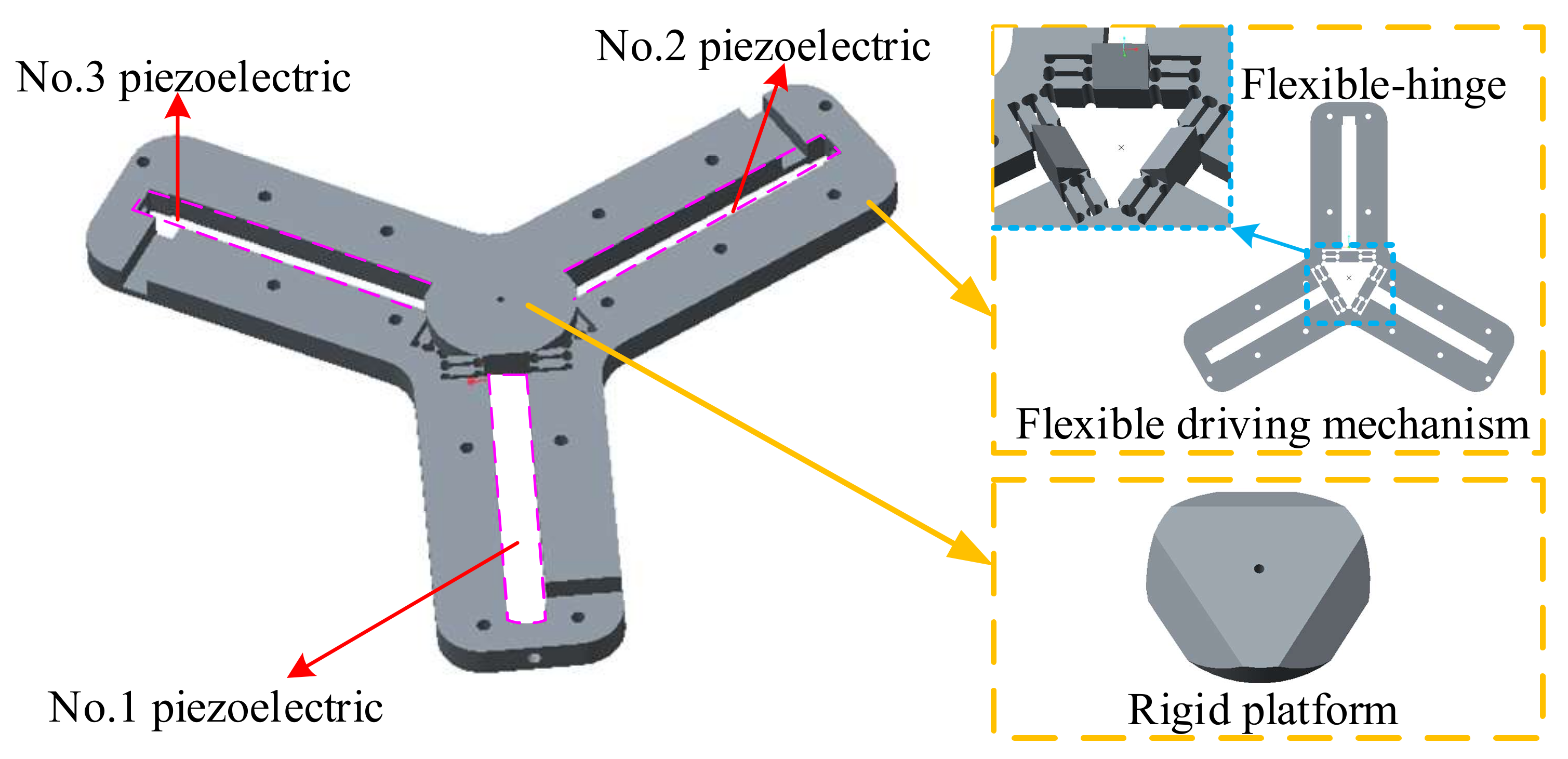
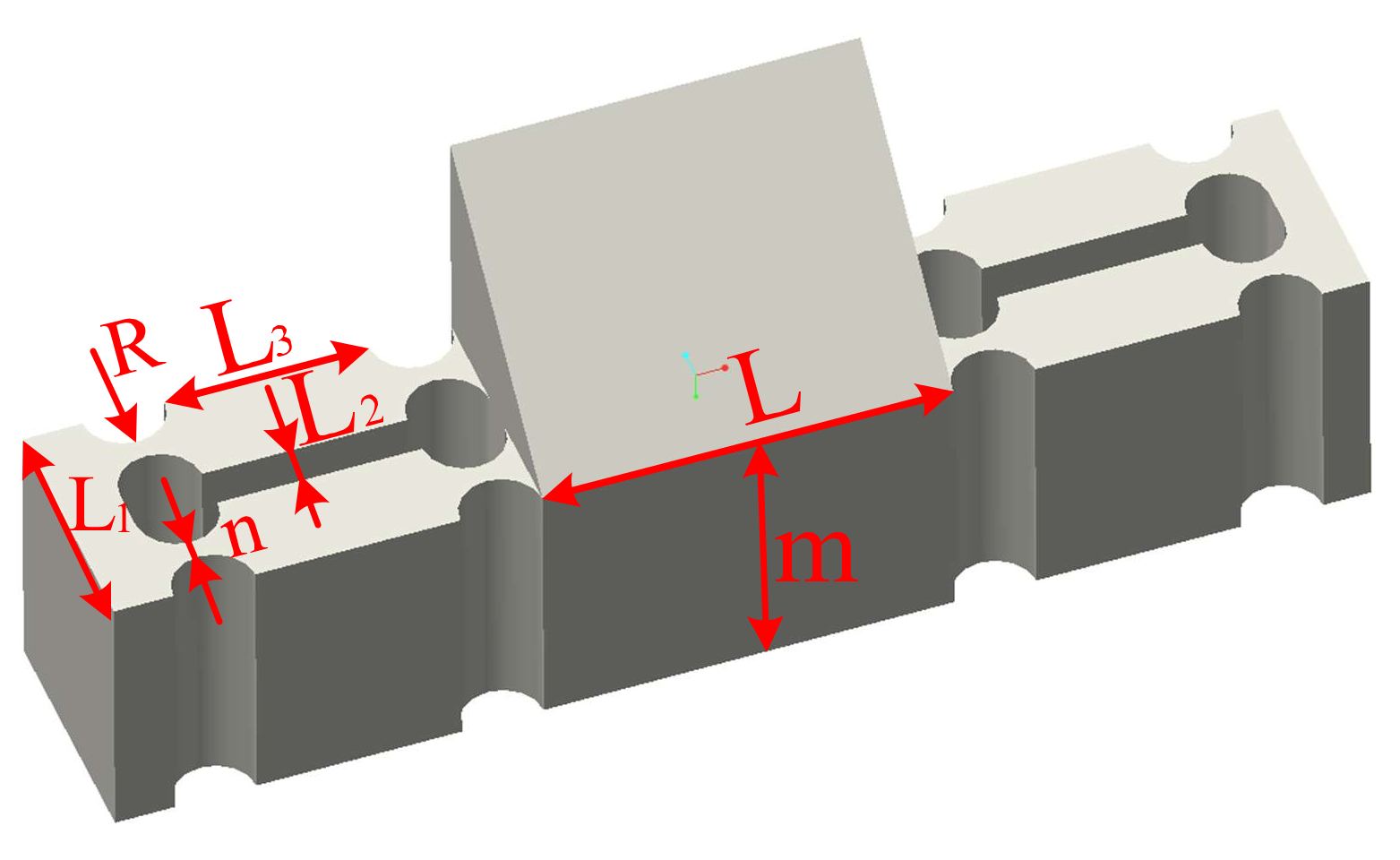
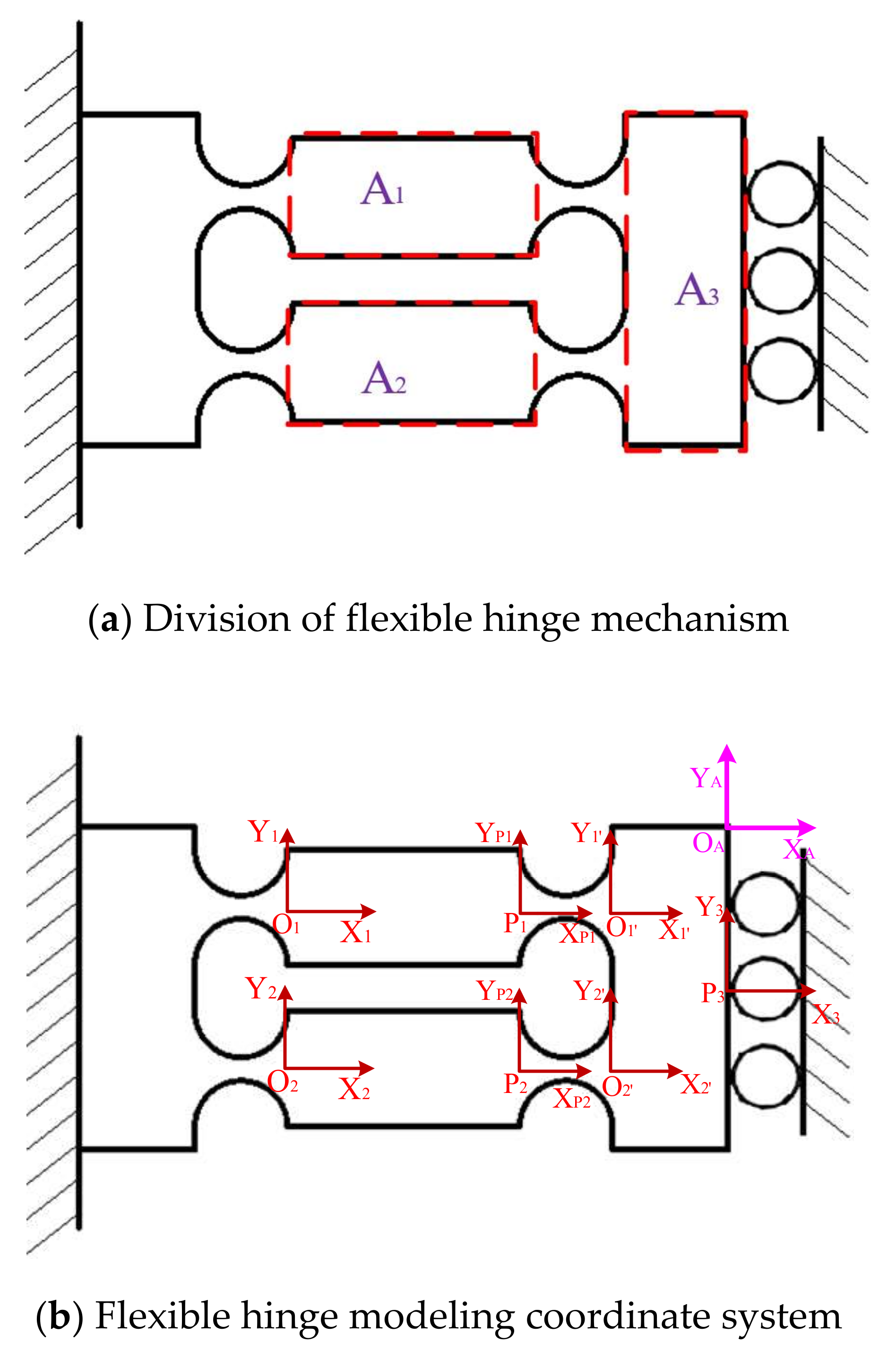
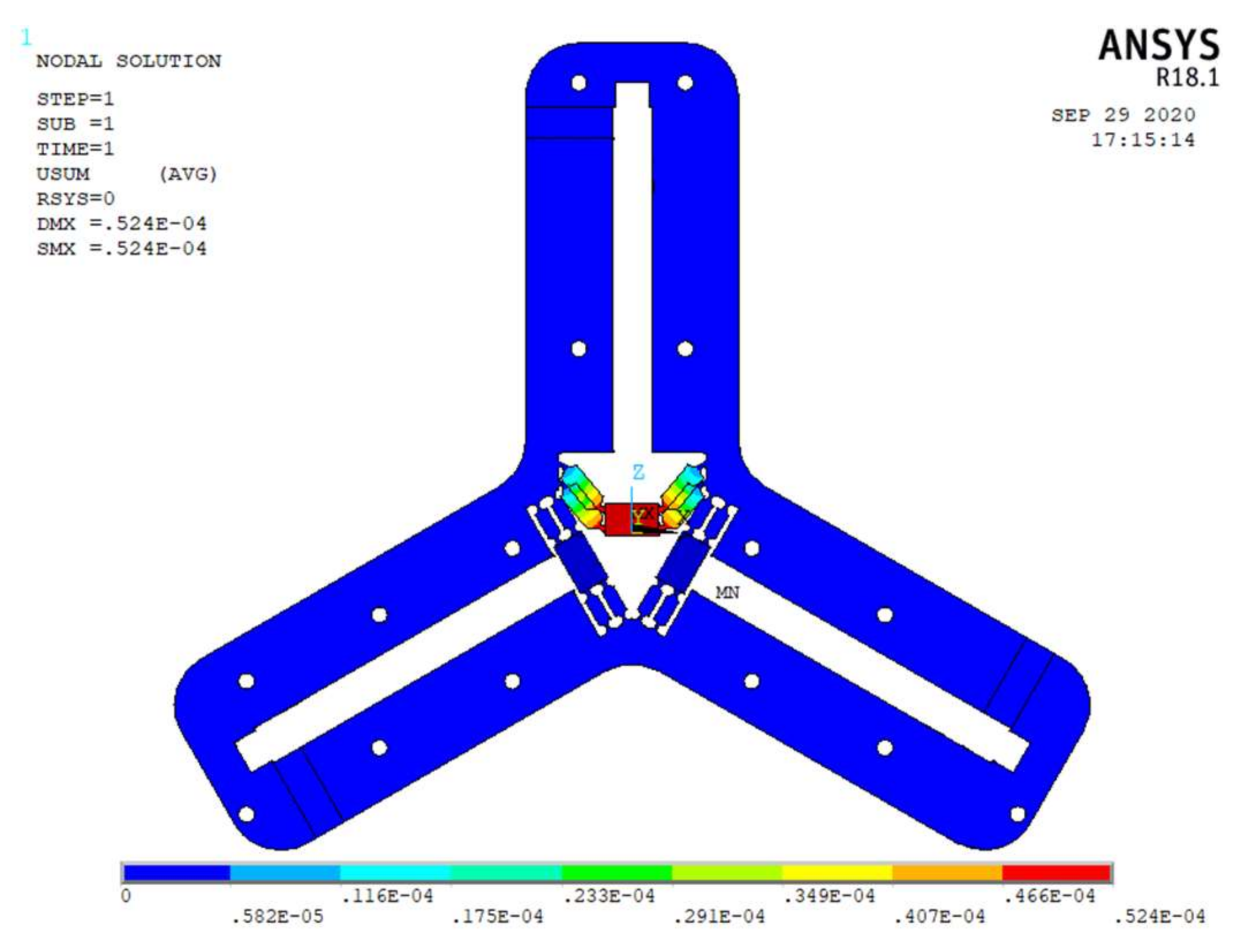

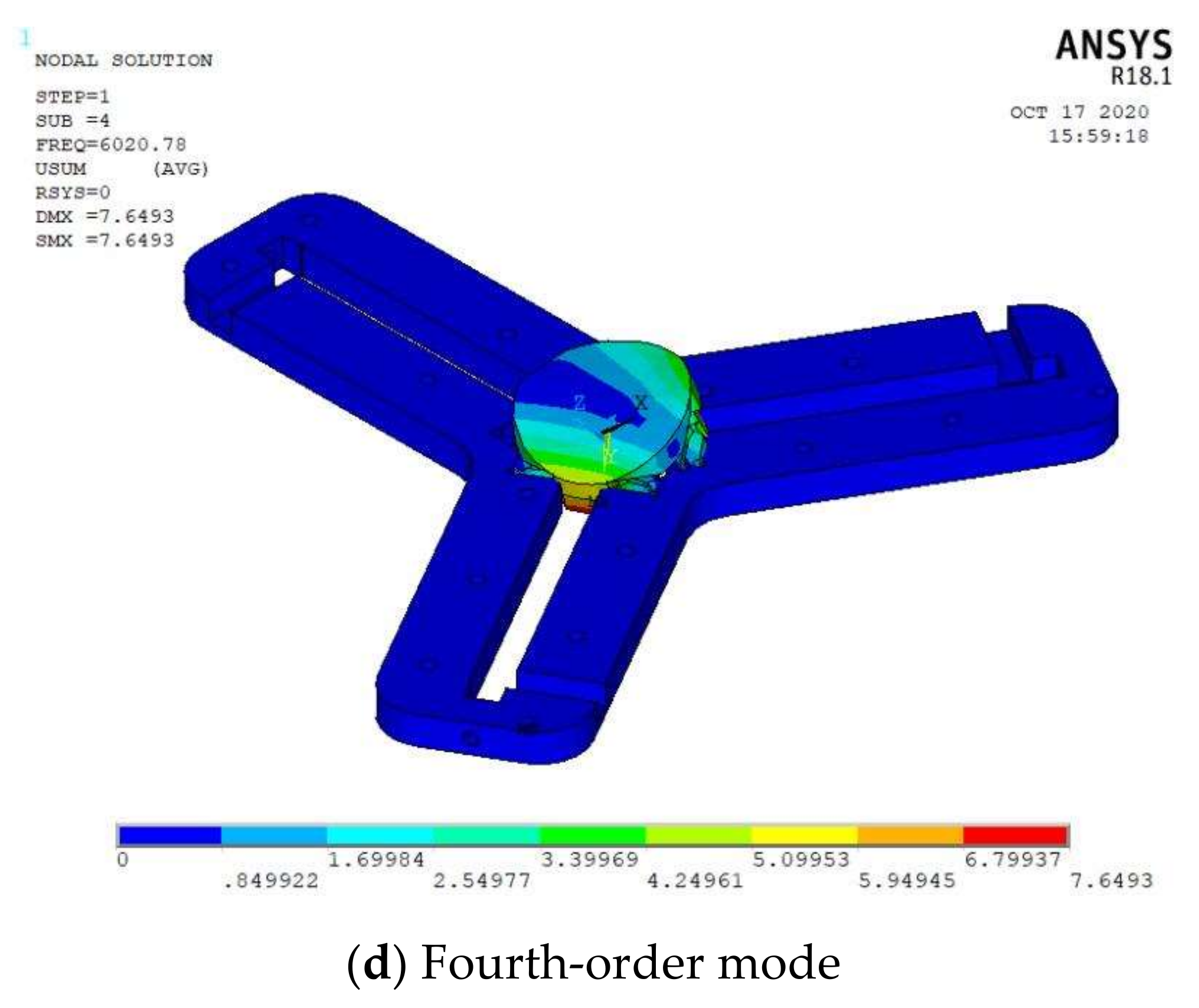
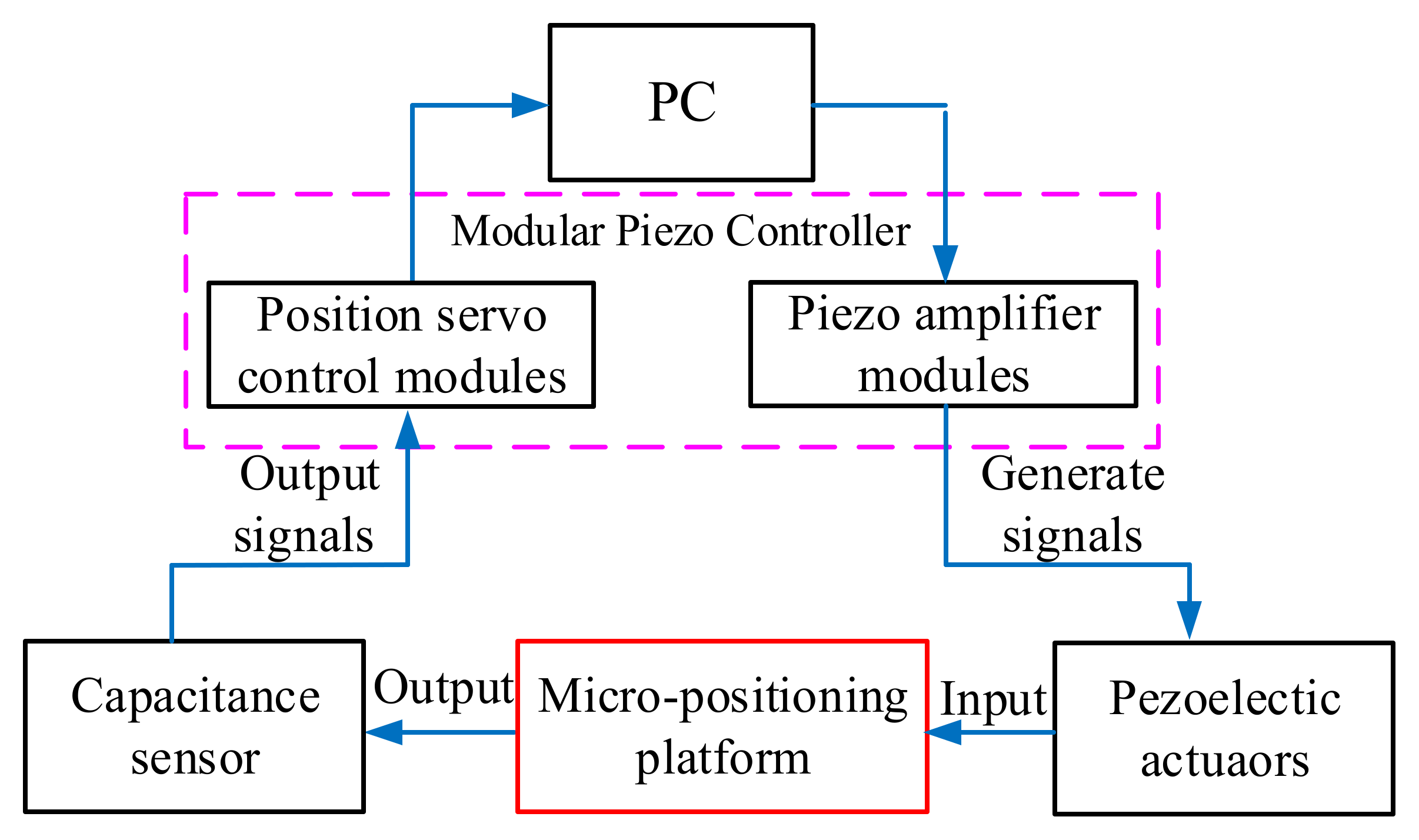

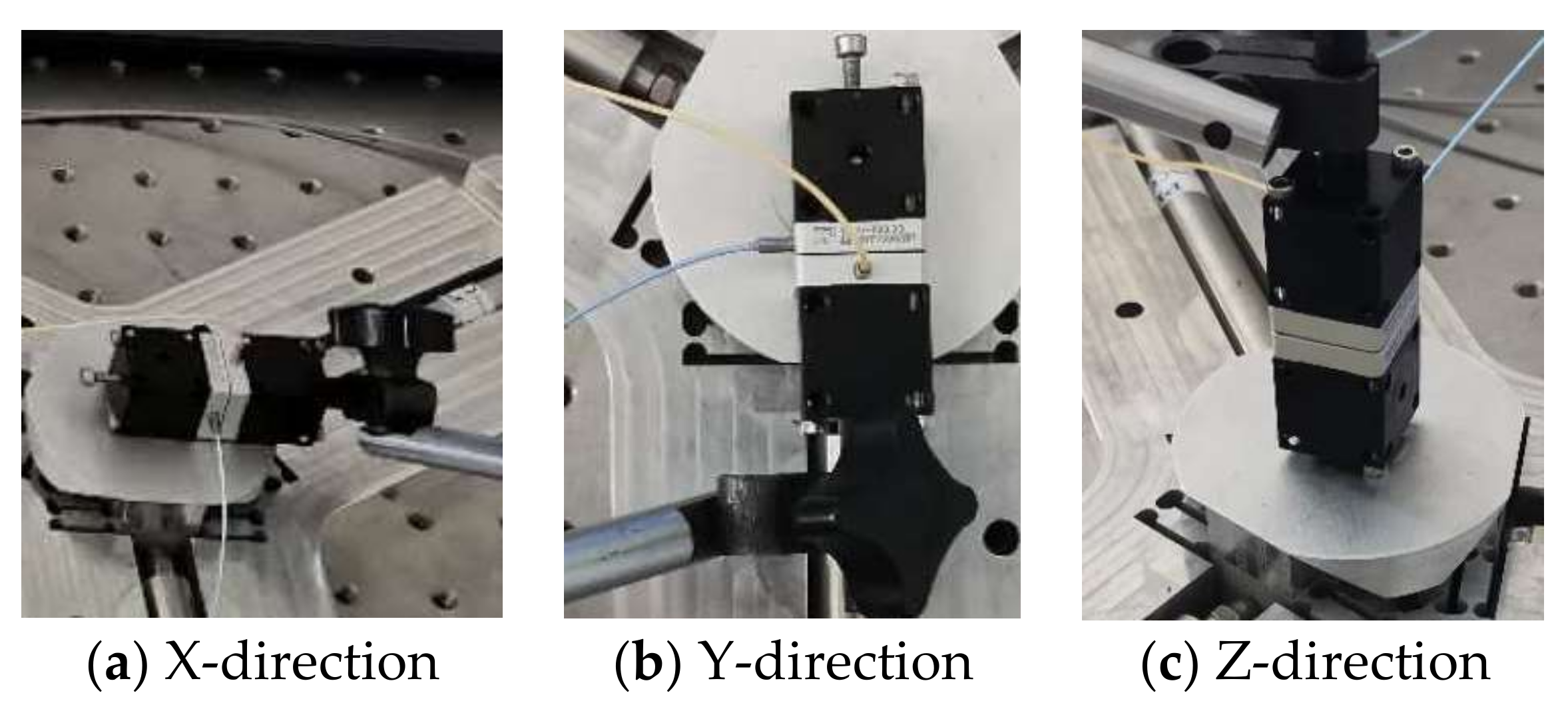
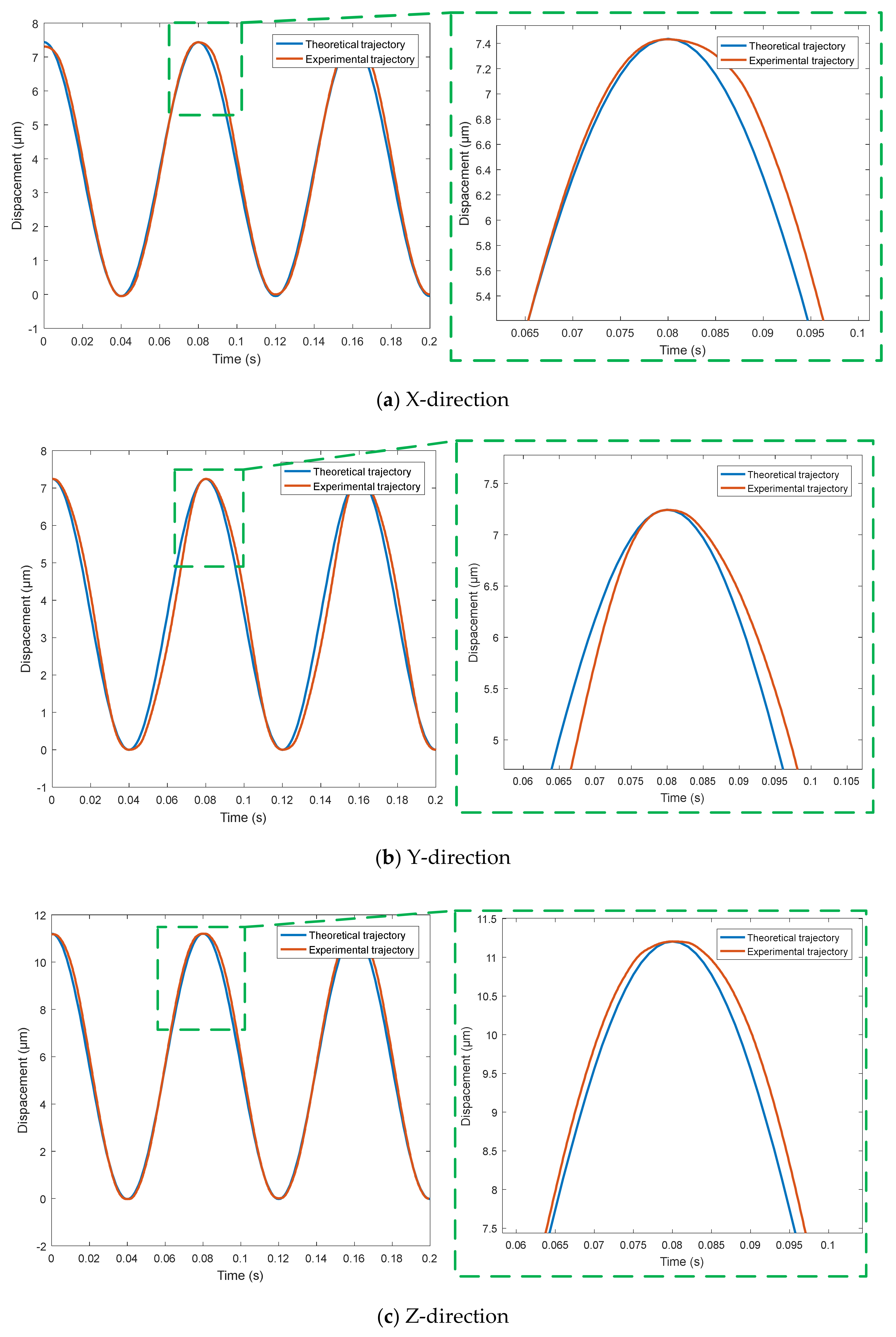
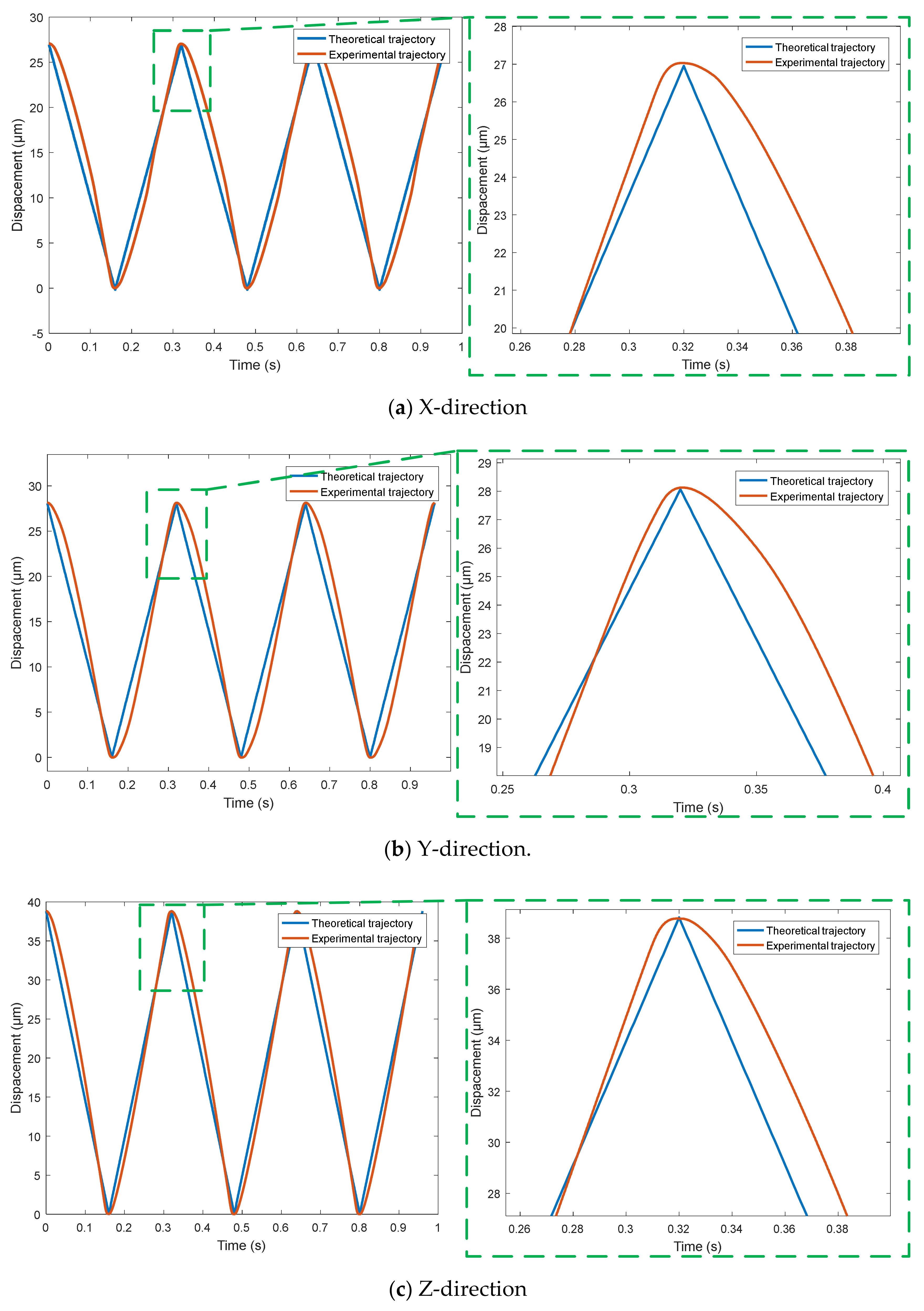



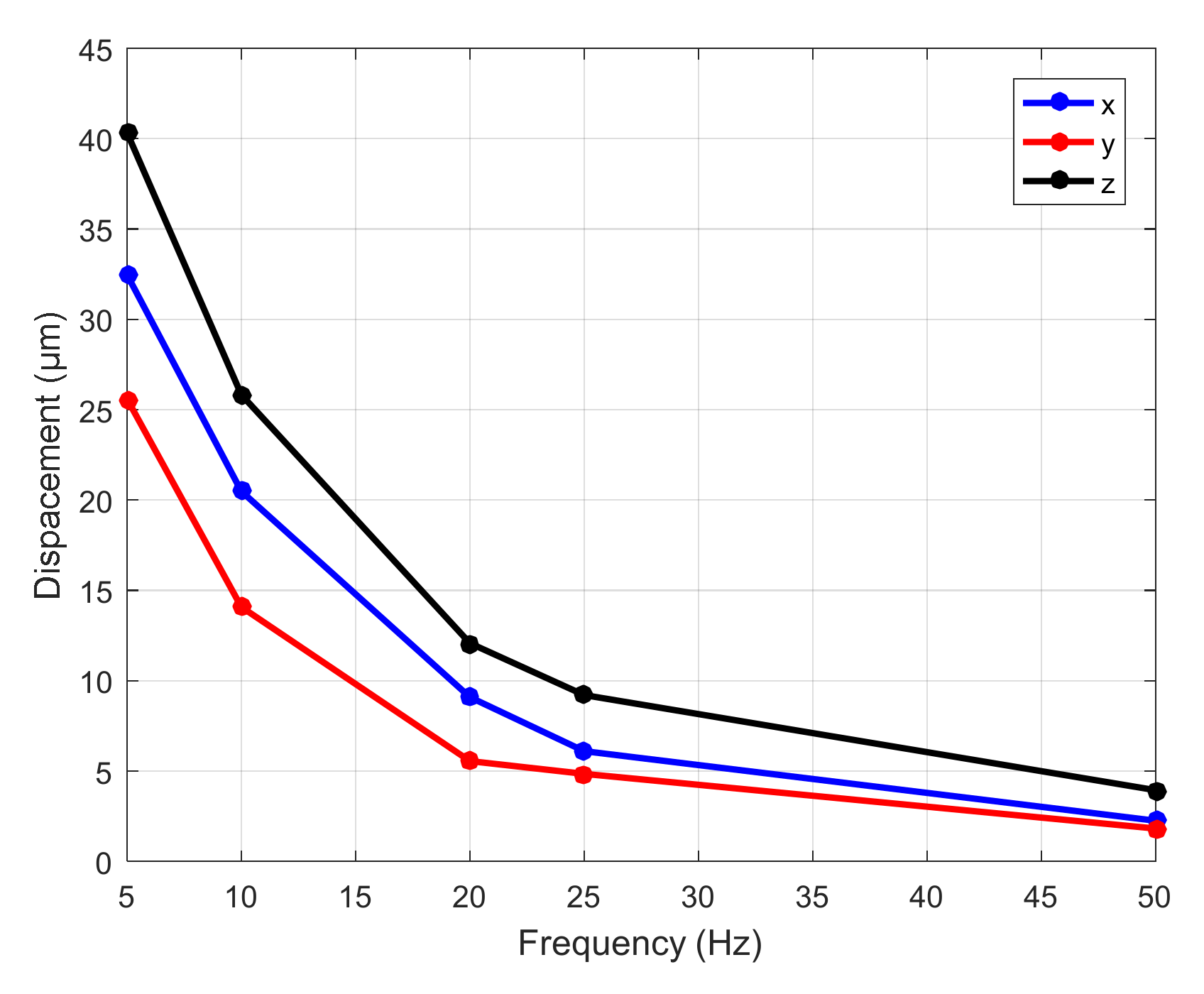
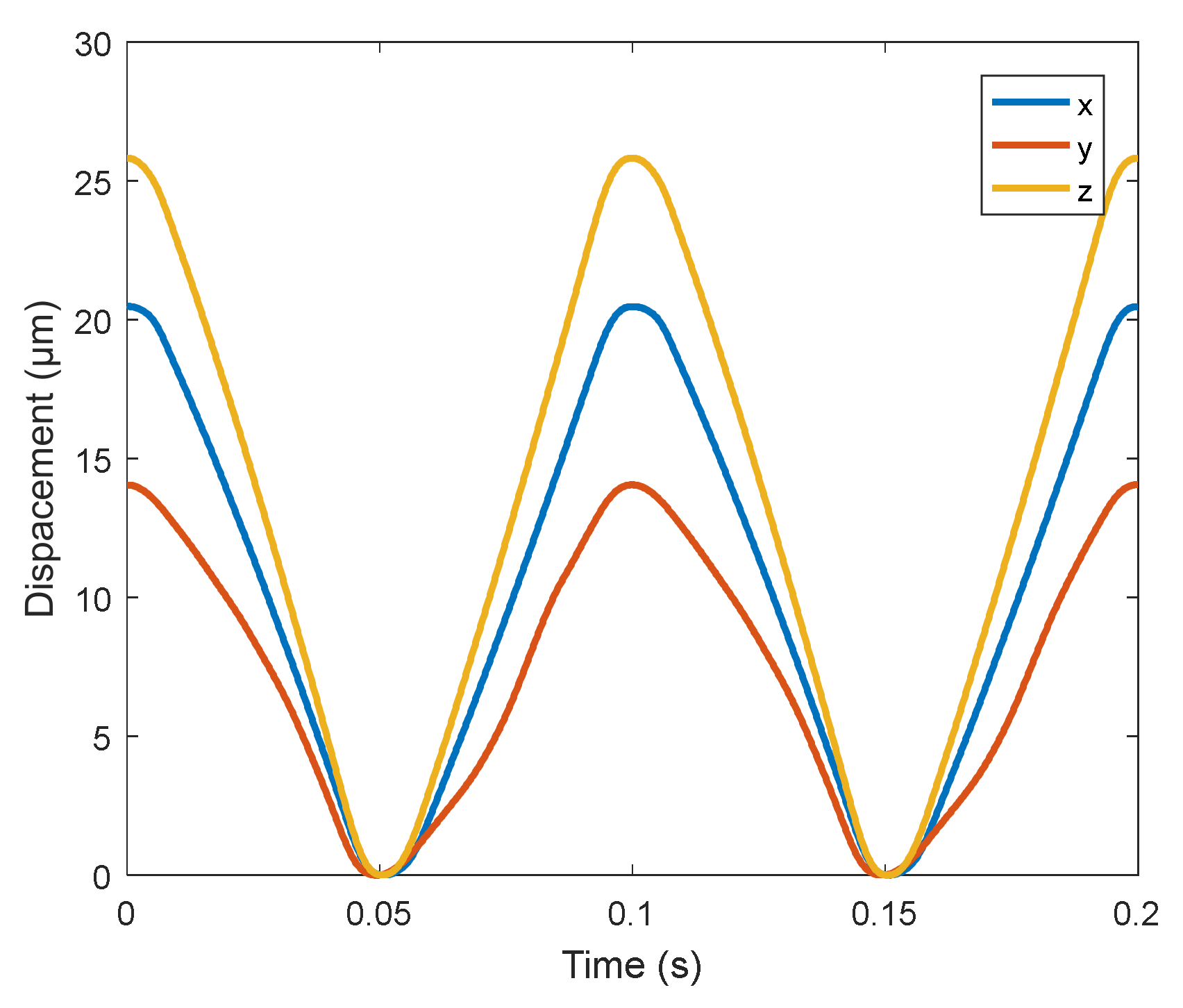


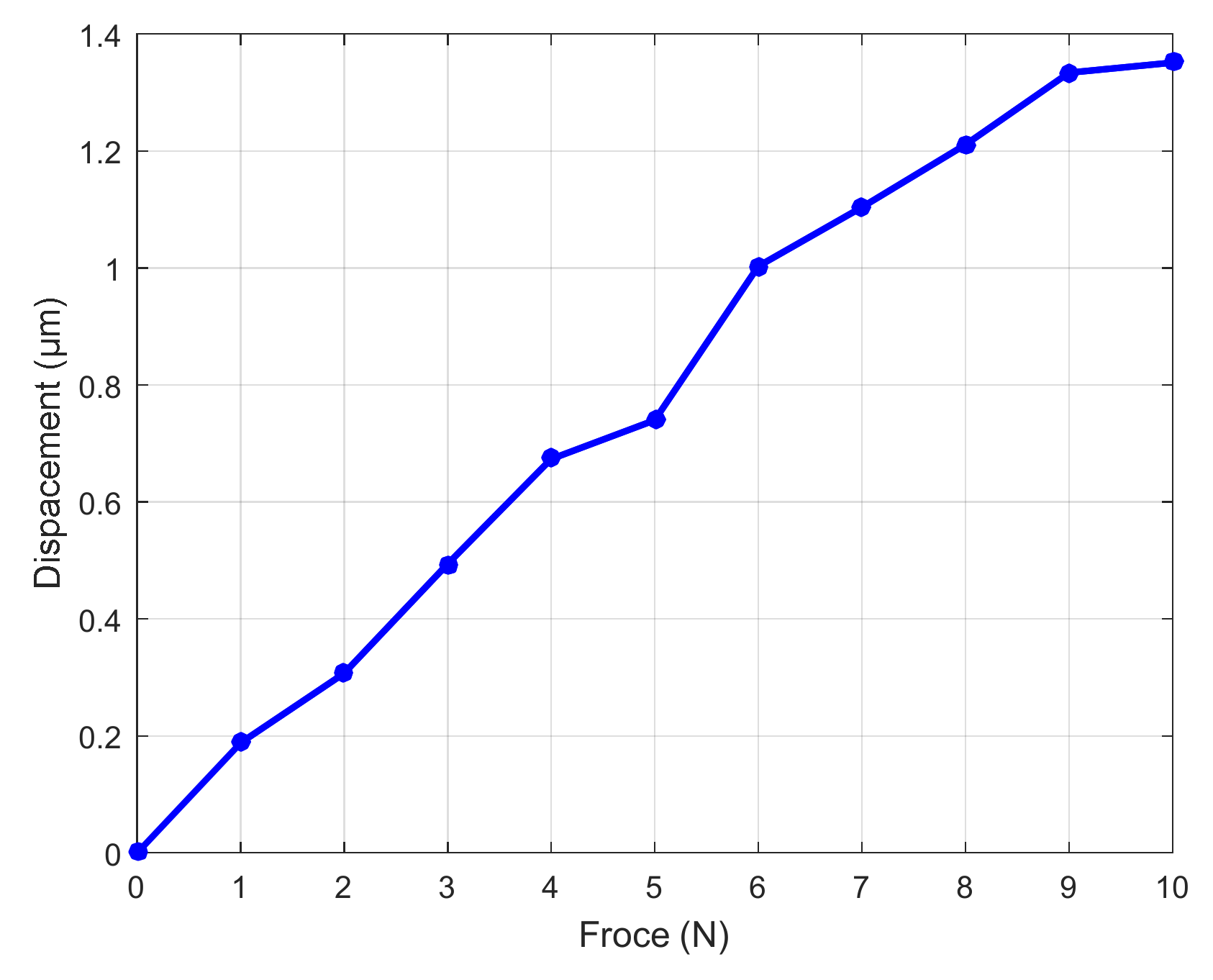

| L(mm) | L1(mm) | L2(mm) | L3(mm) | R(mm) | m(mm) | n(mm) |
|---|---|---|---|---|---|---|
| 20 | 12 | 2 | 10 | 2 | 14 | 1 |
| Force(N) | Variation of Displacement(μm) | Error | |
|---|---|---|---|
| Finite element | 100 | 52.4 | 7.06% |
| MCM | 100 | 48.7 |
Publisher’s Note: MDPI stays neutral with regard to jurisdictional claims in published maps and institutional affiliations. |
© 2020 by the authors. Licensee MDPI, Basel, Switzerland. This article is an open access article distributed under the terms and conditions of the Creative Commons Attribution (CC BY) license (http://creativecommons.org/licenses/by/4.0/).
Share and Cite
Wang, G.; Wang, Y.; Lv, B.; Ma, R.; Liu, L. Research on a New Type of Rigid-Flexible Coupling 3-DOF Micro-Positioning Platform. Micromachines 2020, 11, 1015. https://doi.org/10.3390/mi11111015
Wang G, Wang Y, Lv B, Ma R, Liu L. Research on a New Type of Rigid-Flexible Coupling 3-DOF Micro-Positioning Platform. Micromachines. 2020; 11(11):1015. https://doi.org/10.3390/mi11111015
Chicago/Turabian StyleWang, Guilian, Yong Wang, Bingrui Lv, Ruopeng Ma, and Li Liu. 2020. "Research on a New Type of Rigid-Flexible Coupling 3-DOF Micro-Positioning Platform" Micromachines 11, no. 11: 1015. https://doi.org/10.3390/mi11111015
APA StyleWang, G., Wang, Y., Lv, B., Ma, R., & Liu, L. (2020). Research on a New Type of Rigid-Flexible Coupling 3-DOF Micro-Positioning Platform. Micromachines, 11(11), 1015. https://doi.org/10.3390/mi11111015




